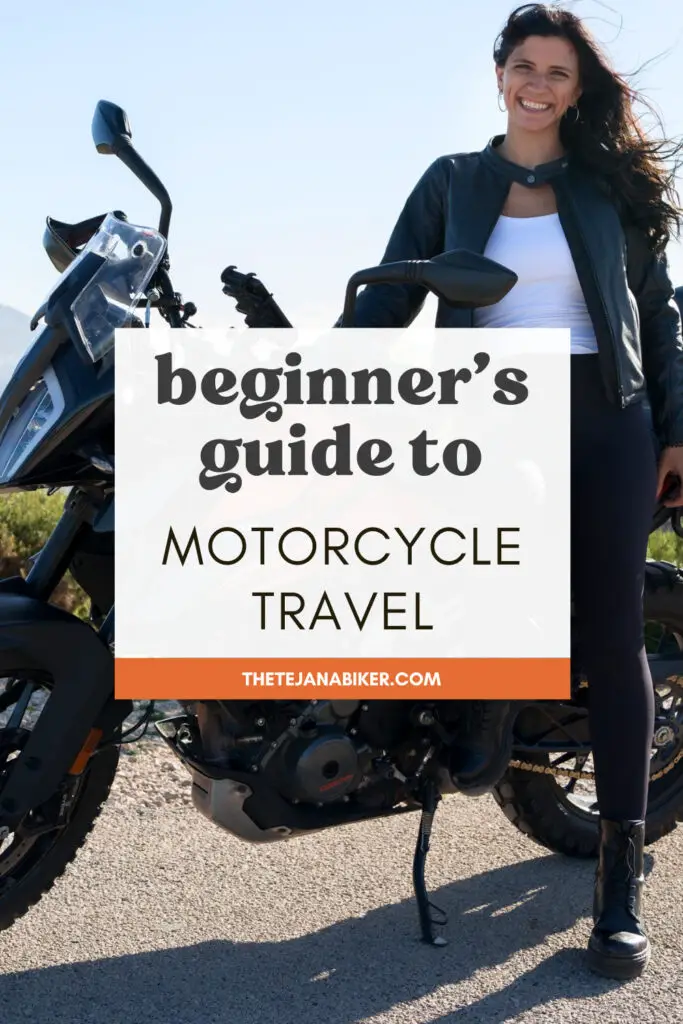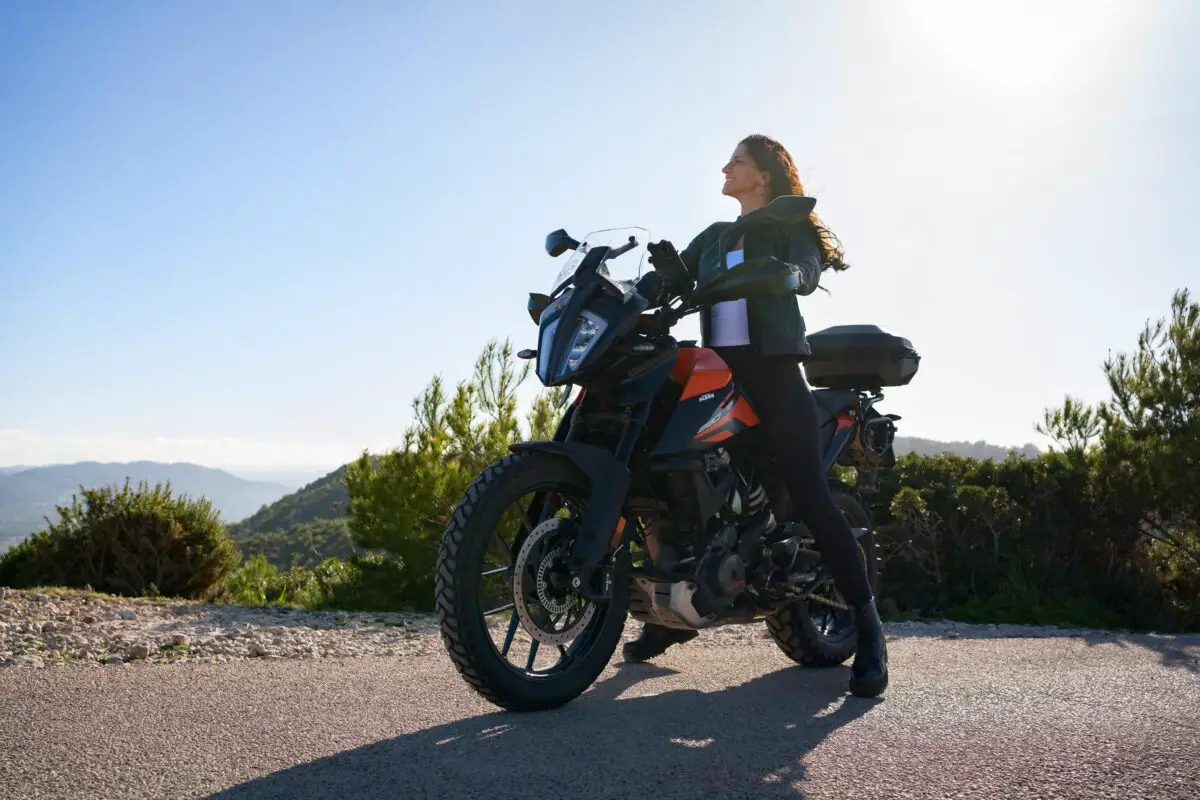
The basics of motorcycle travel: What you need to know about travel on a motorcycle
Please note: This site may contain affiliate links to products. I may receive a commission for purchases made through these links, at no extra cost to you.
Contents
There’s nothing quite like the exhilaration of hitting the open road and starting to travel on a motorcycle. The wind in your hair, the rumble of the engine beneath you, and the promise of new adventures ahead – motorcycle travel is a unique experience that every motorcycle enthusiast should embark upon. Whether you’re a seasoned rider or a novice looking to start your motorcycle road trip, this ultimate guide will equip you with the knowledge and tips you need for an unforgettable motorcycle travel experience.
The basics of travel on a motorcycle
Motorcycle travel is incredibly fun, but comes with a lot of work and preparation. Once you’re on the road though, there’s nothing that beats the thrill of driving through nature with the wind in your hair.
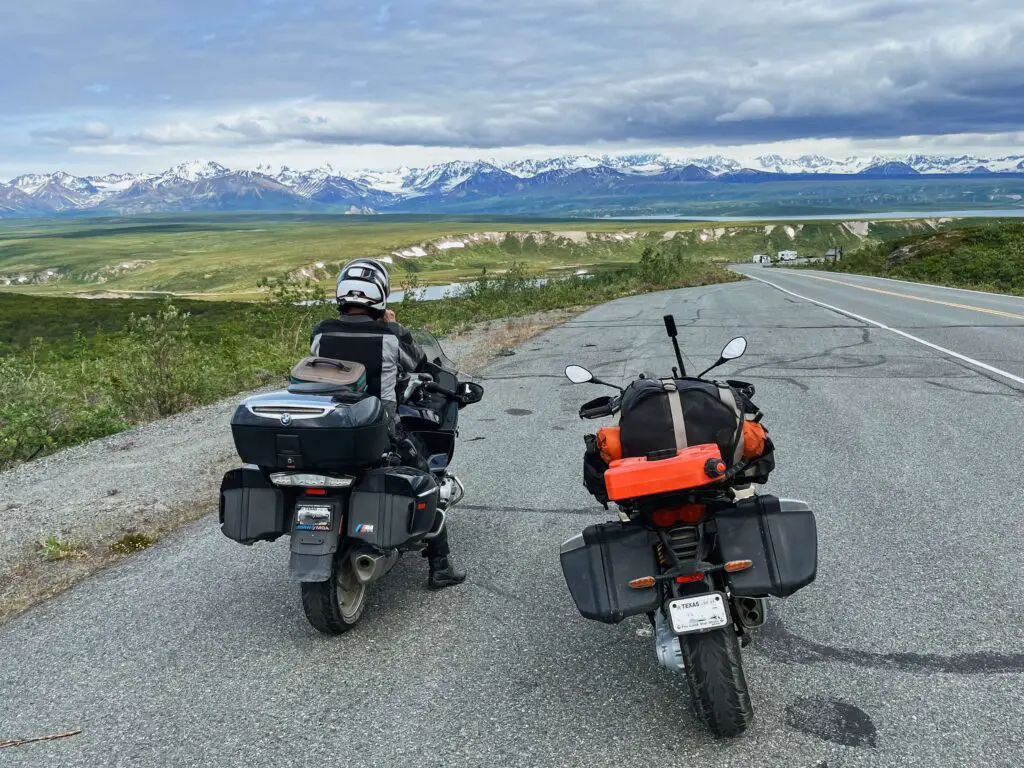
Pros and cons of motorcycle travel
When planning a motorcycle travel trip, there are a variety of issues to consider that you wouldn’t normally think about! While travel on a motorcycle can be amazing, it does have its pros and cons.
Pros of taking a bike:
- Ultimate flexibility – With your own mode of transportation, you can stop where you like for the night, pull over at scenic spots,
- Take in the scenery – I think the only other way to be one with nature would be to take a bicycle or walk. Motorcycling is a close contender.
- Conversation starter with the locals – The amount of times that locals have asked me where I’m going, where I’ve been, etc. is crazy!
- Ability to stay anywhere – Pack your camping gear and you can stay anywhere
- Easier to park – You can fit in between cars and pull over anywhere. Parking is much easier on a motorcycle!
- Just the sensation! – If you love riding motorcycles, you’ll agree that nothing else compares to the sensation.
Cons:
- Expensive – Motorcycles are an expensive hobby! Most of the time, it would be much cheaper to fly or to rent a car. Motorcycle riders do this kind of travel due to one key fact: We just love it!
- Exhausting – You cannot drive a motorcycle the same amount of hours as you can drive a car. You have no one to switch with, and you have to be constantly aware when on the road. It is definitely an exhausting inititative.
- Limited – You don’t have the same amount of space for people or your luggage if you were in a car.
- Subject to weather – If it rains, snows, or is just unbearable hot, you are feeling ALL of it.
- Dangerous – We all know that riding a motorcycle comes with its dangers. Be safe out there.
- Uncomfortable – The right gear and equipment can make you love or hate your trip.
Gear needed for a motorcycle road trip
When preparing for a motorcycle road trip, gear (both for the bike and for your body) is extremely important! You can of course undergo a motorcycle trip without many of the items mentioned, but here are some suggestions that you may not have previously considered.
For the bike:
The first thing you need to do is make sure that your bike is up to par. You don’t want yourself breaking down on the side of the road if you can help it, and there are many modifications you can make to your motorcycle in order to prepare it for longer travel.
Hard or soft luggage
You will need some kind of motorcycle luggage in order to carry everything that you need. There are advantages and disadvantages to both hard and soft luggage.
Hard luggage is more sturdy and better suited for a variety of different weather conditions. Hard luggage is more permanent and is better if you’re wanting a place to lock your helmet in the city for example. However, it can be expensive to mount, depending on your style of motorbike, and the luggage is heavy while driving as well as if you crash.
Soft luggage is more like having several backpacks. You can usually stack them on top of each other and use on different motorcycles. They do not lock easily though (unless you come up with a system yourself), so are better for specific trips and not for permanent use.
My favorite brand for soft luggage is definitely Kriega. They have a variety of different bags that link together, so you can really customize your set-up based on how long your trip. There are also several options on different models of motorcycles for mounting the luggage.
↓ Check out Kriega bags here ↓
For hard luggage I like to go for Givi or sometimes Shad. I love how people with the metal cases collect stickers of all the place they’ve traveled!
↓ You can buy Givi hard lugagge at Revzilla by clicking below ↓
Hand guards
Hand guards/wind deflectors go on your handlebars and are great if you’re planning to do some off-roading, as they protect your hands from rocks and whatever else comes flying up.
↓ You can buy hand guards on J&P Cycles by clicking below or by ordering through your local dealer↓
Fog lights
Fog lights are both for safety and utility. Car drivers can sometimes overlook motorcyclists so adding on fog lights helps to make your bike as visible as possible. They are also useful if you’re riding in the dark or in the rain, simply to help yourself see better, and for others to see you.
↓ Look for fog lights for your motorcycle by clicking below ↓
Comfortable seat or seat pad
On your motorcycle trip, you are going to spend hours and hours sitting, so your seat better be comfortable! Ideally, you would have a custom seat made for your motorcycle by a brand such as Corbin Motorcycle Saddles or Saddlemen. This option is expensive though, and takes time, so sometimes a quick solution is just to buy a comfortable seat pad for your trip.
If you have a passenger, don’t forget that they’re going to want a comfortable seat too!
↓ You can buy seat pads for your motorcycle on Revzilla by clicking below ↓
Bigger windshield
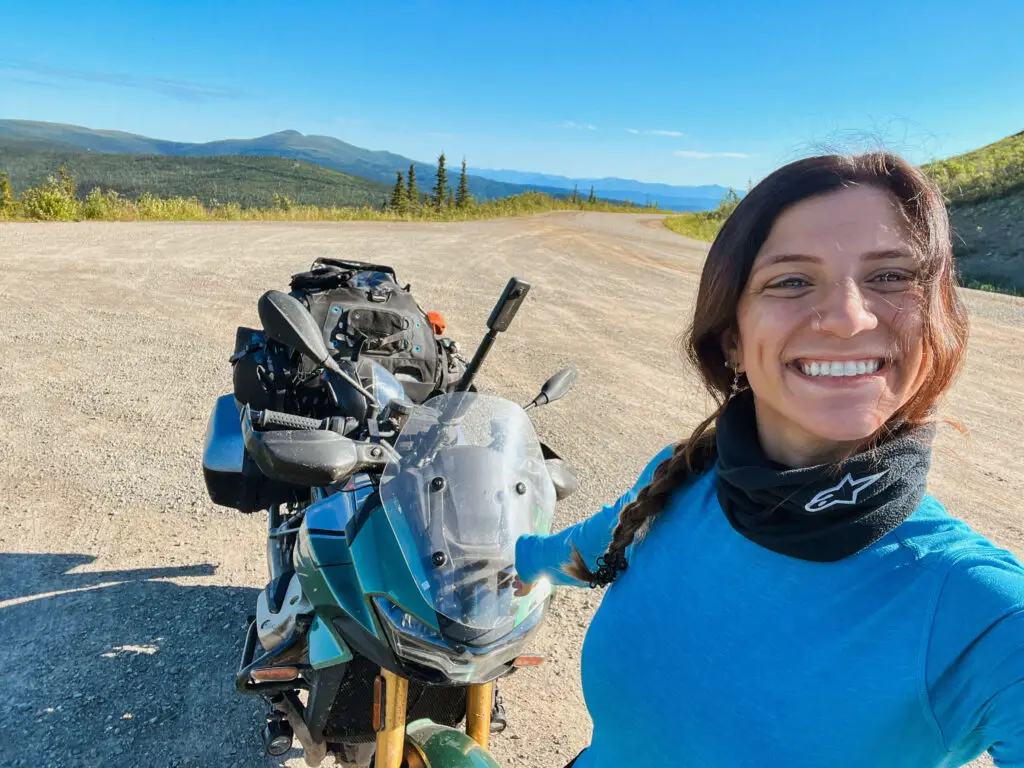
Windshields are fairly cheap, and will help you a lot when it comes to wind and rain. A touring windshield will keep you a bit more dry and will make driving on the highway easier. Smaller windshields or no wind screen at all will cause you to be knocked around in the wind the faster you go.
↓ You can buy wind screens specific to your motorcycle on J&P Cycles by clicking below ↓
Cruise Control
Did you know that if your bike doesn’t come with cruise control, there are ways to add it on? You can easily find add-on cruise controls and throttle locks to add onto your handlebars on Amazon. This will absolutely save your wrist
↓ You can buy throttle locks on Amazon ↓
Heated grips
If you’re planning on riding in the cold, heated grips will save your life! There are several options that can plug into your bike,
↓ You can buy heated grips and controllers on Revzilla clicking below ↓
Charger/Phone stand
You will likely need a phone stand or something set up for GPS anyway for navigating. All that navigation though will drain your phone battery, so I recommend going for a stand where you can plug in your phone at the same time. Many people use a RAM mount, but I personally prefer Quadlock.
↓ You can check my review on Quadlock by clicking below ↓
Tire Repair kit
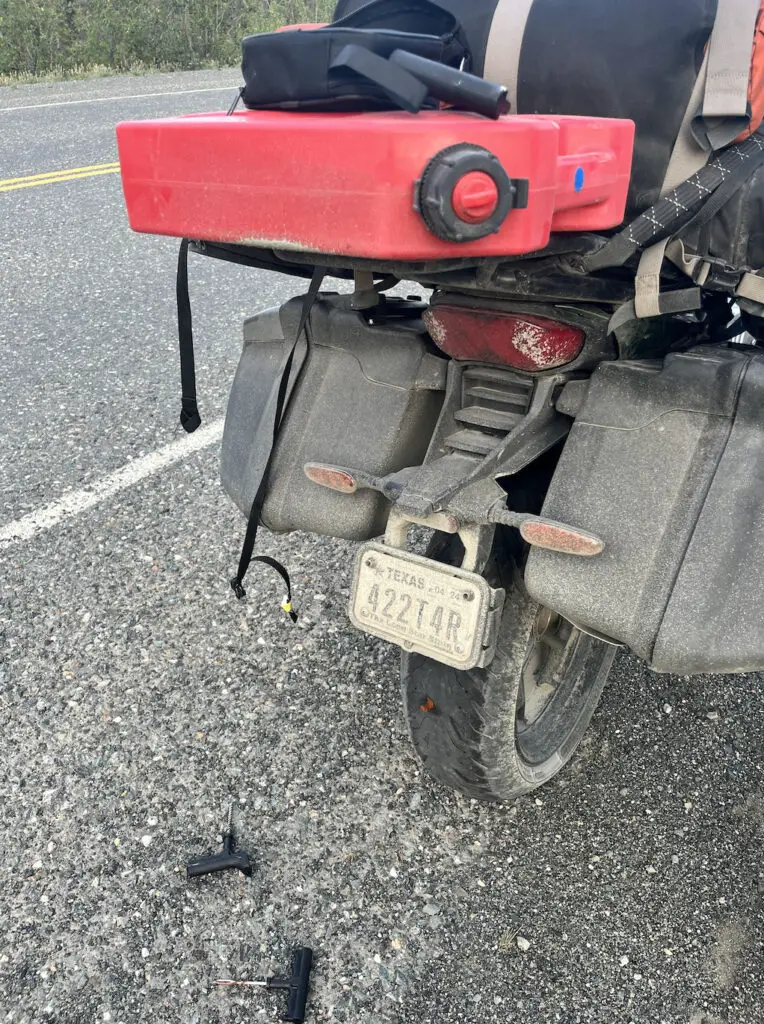
An essential item you should carry with you is a tire repair kit. You never know when you could get a flat, so you need something to use in emergencies in case you’re stranded out on a road.
↓ You can buy different types of tire repair kits on Revzilla ↓
For you:
Helmet with headset
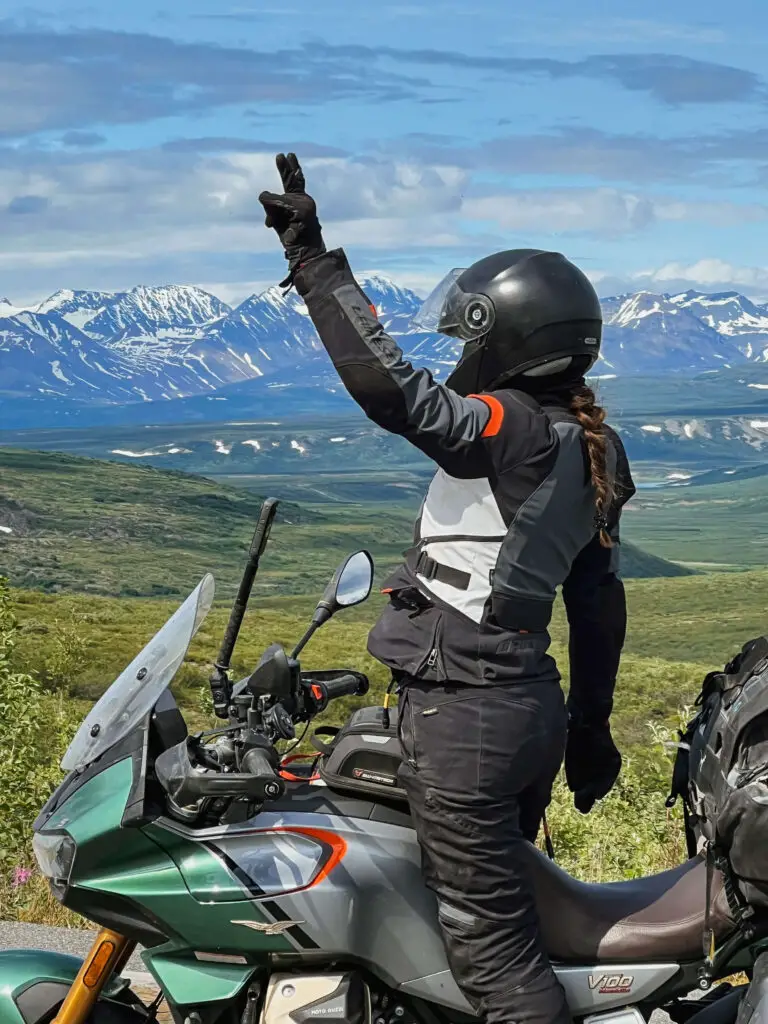
After many hours riding, you’re going to want some form of entertainment, as well as an easy way to communicate with your rider buddies. Earphones are not going to be comfortable the entire time that you are riding, and in some territories it is illegal to drive with them in! That’s why headsets are the way to go.
There are some headsets that are made specifically for a certain style of helmets, and some that you can use regardless of the helmet that you have. I wouldn’t recommend buying a helmet with a built-in headset though, as they are not always the best quality.
I have the Schuberth C3 Pro Helmet with a SENA Bluetooth system. It’s pricey but definitely high quality.
↓ You can check it out here ↓
Earplugs
Spending hours on the freeway with the wind blasting you is terrible for your eardrums. Every experienced motorcycle rider knows that earplugs are essential for long trips.
↓ Buy some sets of earplugs off Amazon ↓
Touring jacket
For motorcycle touring trips, you will need a nice jacket that works in a variety of different weathers, keeping you warm, cool, and dry. Look for jackets that made out of are Goretex, as this is the best waterproof and windproof material, as well as ones that have many jackets for storage.
Definitely the best jacket for touring, waterproof gear is Klim. While they’re pricey, they are the best of the best.
↓ Check out some Klim waterproof jackets here ↓
If you don’t want to commit to that price point just yet, a slightly cheaper version is the Dainese Carve Master line. It’s important to note that only the Carve Masters are made of complete Gore-TEX.
↓ Check it out here ↓
Waterproof pants

As with your jacket, you are also going to need pants that protect you and work for all kinds of weather conditions.
The Klim ones are Gore-TEX in all the right places, while still having bits of leather over your knees for more protection.
Waterproof boots
Let me tell you, when you are on the road and your toes get wet from the rain, you are going to be miserable. No matter how many socks you wear, your toes will still be cold. Waterproof boots are absolutely essential for motorcycle travel.
↓ Check out some of the various styles here ↓
Base layers
There are different kinds of base layers for different functions. The most obvious is going to be thermal layers, which hold in your body heat in colder conditions. You can also buy base layers that regulate your body temperature, which will be useful in the heat and other temperatures. There are motorcycle specific base layers, which I have personally felt work a lot better. My favorites are from Klim and from Dainese.
For a more budget option though, you can check Amazon for some great base layers.
↓ Base layers off Amazon still do the job ↓
Motorcycle Socks
Motorcycle socks that are comfortable and breathable are going to help a lot, especially when breaking in your new motorcycle boots!
↓ Check out some different options below ↓
Cooling vest or heated liner
For extreme temperatures, invest in a cooling vest or heated liner.
The cooling vest is for hot temperatures. It can be wet with cold water and then put underneath your jacket to give you something cool around your body.
↓ Check out some different options below ↓
A heated liner, gloves, jacket, whichever, plugs into the bike and has adjustments to work with varying levels of cold temperatures. They are a complete lifesaver.
If going for a jacket liner, I recommend one with long sleeves over a vest. Make sure the wires go down to your arms as well as your chest and back.
↓ Here are some examples of heated gear ↓
How to plan a motorcycle touring trip
Tour vs. on your own
The first thing you should decide is whether you should find a tour agency or go it alone. If you’re driving with your own bike, it makes sense to just brave it alone and figure out everything along the way though. If you’re in a foreign country or simply too far from your bike in the garage though, you will need to rent a motorbike, and sometimes you can find tour agencies to help you do this.
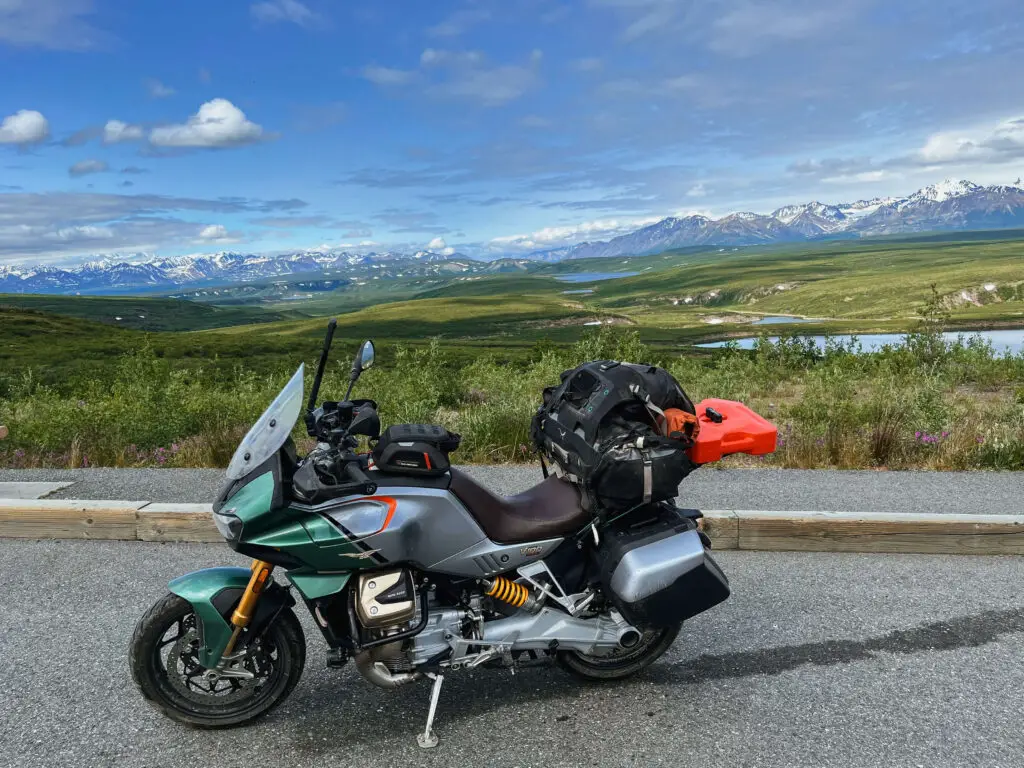
Best apps for trip planning
Google Maps works great, but here are a couple motorcycle travel specific apps for planning your motorcycle road trip, so you can find all the best motorcycle roads:
- Rever
- Calimoto
- EatSleepRIDE
- Scenic
- Best Biking Roads
Checking road regulations
Always, always, always check the laws of the road before driving in a different territory. Certain countries require helmets, require you to have a high visibility vest in case of emergencies, and restrict the use of earphones. In Spain for example, I once had to pay a 250 euro fine because I didn’t have original copies of every single one of my documents, only the digital version! Check laws and road regulations before the trip so you aren’t taken by surprise.
Things to consider before your motorcycle travel trip
Where will you stay?
Travel on a motorcycle is the same as travel any way else, except you have the burden and the luxury of carrying everything you need with you. You have the option of staying in hotels after an entire day of roughing it out, or you can pack camping gear with you and just pitch it out wherever you want! The choice is up to you.
How long can you drive?
Every rider is different, and a lot of your stamina depends on the comfort of your bike.
Try to do some shorter, test drives on the weekends to see about how many hours you can average in a day. The last thing you want to do is over-estimate and be stuck with a schedule that makes you miserable on your trip.
Going off-road
Something amazing about being on a motorcycle is getting to go off-road. If you plan on going off-road, be sure you have the correct tires and someone with you in case of an emergency.
Packing fuel cells, extra chargers, and other add-ons
Depending on where you go, consider some add-ons, such as extra chargers and portable batteries for your helmet and phone in case your main charger stops working, and a fuel cell to carry extra fuel so you never have to worry about running out of gas.
I hope you enjoy travel on a motorcycle as much as I do! Enjoy your trip!
